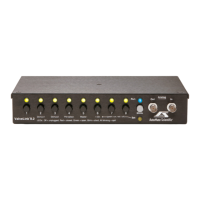Valves
Adjust flow rate by height of syringe reservoirs.
Watch flow rate in drip chambers
Adjust flow rate with thump clamp
Inflow manifold
Ground
electrode
slots
Suction tube
Flow rate
adjustment
screw
Good liquid level
BAD!
GOOD
May suck chamber dry,
but may stop oscillations.
Caution:
Suction tube well:
Cover and ground
suction tube with
aluminum foil
to minimize noise
As long as these tubes are prefilled (primed)
with solution, then opening valves upstream
starts liquid flowing inside the manifold here.
Perfusion Cheat Sheet
Your perfusion system may not include optional drip chambers, thumb
clamps or the Petri dish chamber, but these hints from Woods Hole
may still help.
Installation Tips
• Flow rate is adjusted by the relative height of reservoirs and manifold
ow regulator plus optional air pressure.
• Leave the tubing between the reservoirs and valves long enough to raise
and lower the reservoirs.
• Unused lines should be replaced with plugs on manifold, or temporarily
clamped-o just above manifold to avoid back bleeding into empty lines.
They MUST also be lled with solution.
• Priming one line at a time reduces bubbles.
• Connect your vacuum trap line directly to the outow of the manifold
for running cleaning solutions and drying your lines quickly.
• Determine dead volume from the manifold to prep by measuring time
and volume required to ush a colored liquid with a clear one. Calibrate
ow rates by running one line into a graduated cylinder for a xed
period of time.
• Filter solutions down to 5-10 microns when using PTFE or Lee valves.
• See more tips in the "Techniques" chapter later in this manual.
Bubbles and Degassing
Bubbles are often caused by outgassing. This is particularly true when
media is stored cold overnight and allowed to warm to room temperature
in the perfusion system tubing. Since warm liquids hold less gas, bubbles
will form in the tubing and valves as gas leaves the media. The best
solution is to pre-warm your solutions by at least 2-3 degrees above
room temperature even if you are adding gas (CO
2
, Carbogen, etc.) to
your reagents. If you are using an inline heater like the ThermoClamp,
it is a good idea to warm solutions 2-3 degrees above your inline heater
temperature to prevent bubbles from forming there. If possible, keep
the solutions in the reservoirs at this higher temperature all day using
reservoir heaters.
Degassing can also be facilitated by applying a slight vacuum to the
reservoirs, although this is not recommended if you are purposely gassing
your media.
11
10

